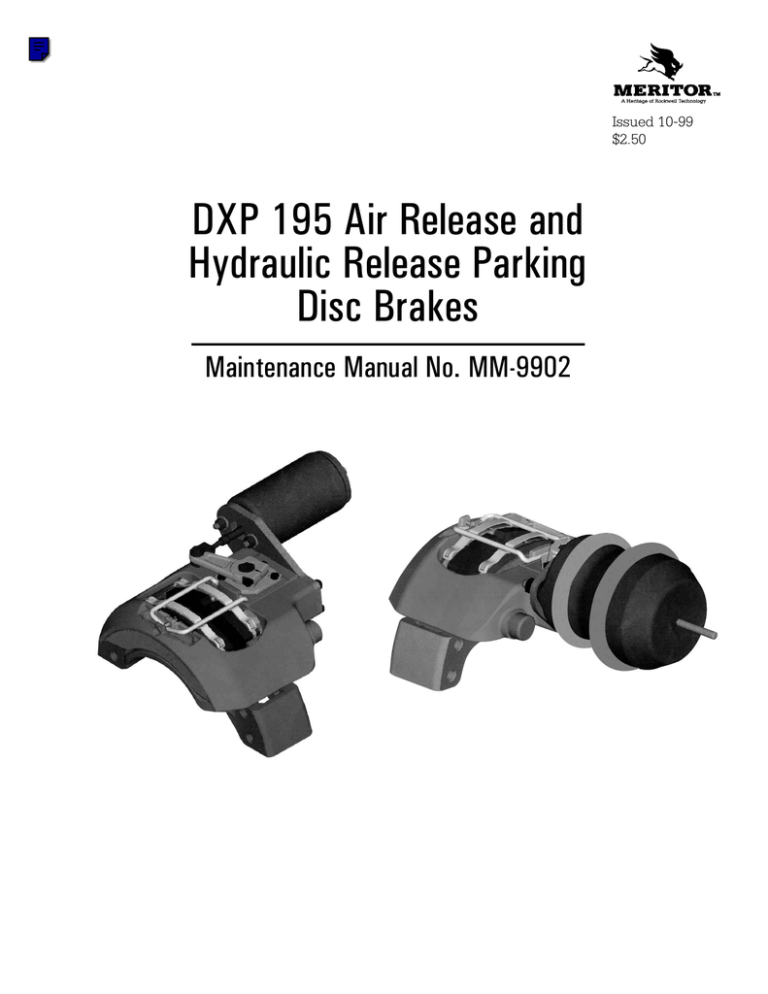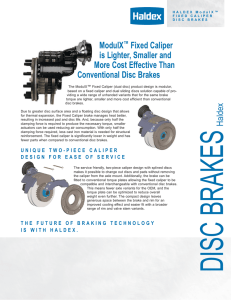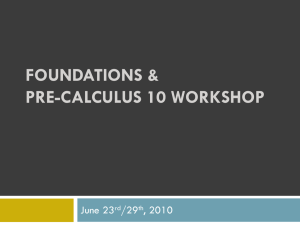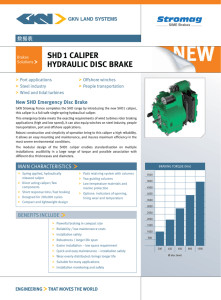
Issued 10-99
$2.50
DXP 195 Air Release and
Hydraulic Release Parking
Disc Brakes
Maintenance Manual No. MM-9902
Service Notes
This publication provides maintenance and service procedures for Meritor's DXP 195 air release and
hydraulic release parking disc brakes. The information contained in this publication was current at the time
of printing and is subject to revision without notice or liability.
1. You must understand all procedures and instructions before you begin maintenance and service
procedures.
2. You must follow your company's maintenance and service guidelines.
3. You must use special tools, when required, to avoid serious personal injury and damage to
components.
Meritor uses the following notations to warn the user of possible safety problems and to provide
information that will prevent damage to equipment and components.
WARNING
A WARNING indicates a procedure that
you must follow exactly to avoid serious
personal injury.
NOTE: A NOTE indicates an operation, procedure
or instruction that is important for proper service.
A NOTE can also supply information that can help
to make service quicker and easier.
CAUTION
A CAUTION indicates a procedure that
you must follow exactly to avoid damaging
equipment or components. Serious personal
injury can also occur.
Visit Our Web Site
Visit the Technical Library section of
www.meritorauto.com for additional product and
service information on Meritor's Heavy Vehicle
Systems component lineup.
Technical Electronic Library on
CD
The CD includes product and service information
on Meritor's component lineup. $20. Order
TP-9853.
How to Order
Call Meritor's Customer Service Center at
800-535-5560.
This symbol indicates that fasteners must
be tightened to a specific torque.
Table of Contents
Asbestos and Non-Asbestos Fibers Warnings ................................................................1
Section 1: Exploded View........................................................................................................2
Section 2: Introduction
Description..............................................................................................................................4
Identification ..........................................................................................................................5
Section 3: Disassembly
Remove the Linings..................................................................................................................6
Remove the Caliper Assembly ..................................................................................................7
Section 4: Assembly
Install the Caliper Assembly ......................................................................................................8
Install the Linings
Adjust the Initial Caliper Clearance ............................................................................................9
Section 5: Maintenance
Hydraulic Fluid ......................................................................................................................10
Inspection Schedule
Check the Adjusted Chamber Stroke Length
Inspect the Brake Components ................................................................................................11
Cleaning ..............................................................................................................................13
Section 6: Diagnostics
DXP 195 Air Release and Hydraulic Release Parking Disc Brakes ................................................15
Section 7: Specifications
Torque Specifications ............................................................................................................16
Notes
Asbestos and Non-Asbestos Fibers
1
Section 1
Exploded View
Spring-Applied Air Release Brake (Left-Hand Brake)
6
5
8
4
7
9
10
3
1
2
Item
Description
Sequence Number *
Item
Description
Sequence Number *
1
2
3
4
5
Chamber
Pin
Cotter Pin
Spacer
Lining Assembly
00100
00110
00120
00130
00140
6
7
8
9
10
Spring
Retaining Pin
Cotter Pin
Washer
Adjuster Plug
00150
00160
00170
00180
00190
* Sequence numbers appear in the bill of material available from the equipment manufacturer.
2
Section 1
Exploded View
Spring-Applied Hydraulic Release Brake (Left-Hand Brake)
7
6
9
5
8
3
2
4
1
10
11
Item
Description
Sequence Number *
Item
Description
Sequence Number *
1
2
3
4
5
6
Chamber
Spacer
Pin
Cotter Pin
Spacer
Lining Assembly
00100
00105
00110
00120
00130
00140
7
8
9
10
11
Spring
Retaining Pin
Cotter Pin
Washer
Adjuster Plug
00150
00160
00170
00180
00190
* Sequence numbers appear in the bill of material available from the equipment manufacturer.
3
Section 2
Introduction
Description
Figure 2.1
The DXP 195 dry disc parking brake fits a
14.88-16.54-inch (378-420 mm) disc range and
can be packaged as a driveline, wheel end or
axle-mounted park brake. It is designed for use
in off-highway haulers, mining vehicles, front-end
loaders and various stationary machinery.
•
The brake features a lightweight
single-piece cast caliper, supported on
twin slide pins, which is fixed to a
"universal" mounting saddle.
•
Brake pads are located in the saddle and
are easily accessible for inspection or
replacement.
•
The actuation device, with air or hydraulic
release, can be placed in multiple positions
to clear other components for easy
packaging.
•
4
Additionally, the brake can mount in any
position around the disc.
Figures 2.1 and 2.2.
Figure 2.2
Section 2
Introduction
Identification
To identify the DXP 195 assembly, refer to the
tag located on the chamber bracket. Figure 2.3.
Figure 2.3
5
Section 3
Disassembly
Remove the Linings
CAUTION
WARNING
To prevent serious eye injury, always wear safe
eye protection when you perform vehicle
maintenance or service.
Do not work under a vehicle supported only by
jacks. Jacks can slip or fall over and cause
serious personal injury. Support the vehicle with
safety stands.
1. Block the wheels of the vehicle to prevent
the vehicle from moving.
2. If necessary, raise the vehicle. Support the
vehicle with safety stands.
3. Remove the adjuster plug and washer from
the chamber bracket. Figure 3.1.
Figure 3.1
Use an Allen wrench to manually adjust and
de-adjust the brakes. Do not use an air gun to
adjust or de-adjust the brakes. Damage to
components can result.
Stop turning the Allen wrench when you feel
resistance. Do not continue to turn the Allen
wrench beyond the resistance point. Damage to
components can result.
NOTE: When you de-adjust the brake (increase
disc clearance), you will hear a "'clicking" sound
and feel a "pulsing" sensation during the
adjustment.
4. Use a 6 mm Allen wrench to de-adjust the
brake as specified on the brake caliper and in
Table A below. Stop turning the Allen
wrench when you feel resistance, which
indicates that the adjuster pistons are fully
retracted. Figure 3.2.
• To ensure that the automatic adjustment
will occur: Adjust the brake an additional
¼-turn after you reach the resistance
point.
WASHER-ADJUSTER PLUG
Figure 3.2
ALLEN
WRENCH
ADJUSTER PLUG
ALLEN
WRENCH
Table A: Increasing and Decreasing Disc Clearance
Caliper Identification
Increase Disc Clearance
Decrease Disc Clearance
LH Air Release Brake Assembly
Counterclockwise
Clockwise
RH Air Release Brake Assembly
Clockwise
Counterclockwise
LH Hydraulic Release Brake Assembly
Counterclockwise
Clockwise
RH Hydraulic Release Brake Assembly
Clockwise
Counterclockwise
6
Section 3
Disassembly
5. Remove the stabilizer bar cotter pin and
retainer pin. Hinge the stabilizer bar so it is
out of the way. Figure 3.3.
Figure 3.3
Remove the Caliper Assembly
CAUTION
Do not use the stabilizer bar to lift the caliper on
or off of the vehicle. Damage to the stabilizer bar
can result.
1. Remove the brake linings. Refer to "Remove
the Linings" in this section.
2. Remove the clevis pin from the lever.
Figure 3.4.
3. Remove the chamber. Figure 3.4.
4. Remove the four saddle bolts.
5. Lift the caliper and saddle assembly away
from the disc.
• If shims are used between the saddle and
bracket: Mark the position of the shims.
6. Lift the inner lining out of the caliper
assembly. If you plan to reuse the lining,
mark the lining INBOARD.
7. Slide the caliper OUTWARD and remove the
outboard lining. If you plan to reuse the
lining, mark the lining OUTBOARD.
NOTE: If the caliper moves past its working
position and jams on the slide pins, use a rubber
mallet to move the caliper back to its working
range.
Figure 3.4
AIR CHAMBER NUT
COTTER PIN AIR
CHAMBER CLEVIS
WASHER-AIR
CHAMBER NUT
CLEVIS PIN
LEVER
8. Verify that the caliper slides freely on the
slide pins.
9. Remove dirt and dust from the lining contact
surfaces of the saddle.
10. Inspect the caliper boots. If the boots are
damaged, replace the caliper/saddle
assembly.
AIR CHAMBER
CALIPER AND SADDLE ASSEMBLY
11. Inspect the disc for wear and damage. Refer
to Section 5.
7
Section 4
Assembly
Install the Caliper Assembly
WARNING
To prevent serious eye injury, always wear safe
eye protection when you perform vehicle
maintenance or service.
Use Meritor parts only. Do not use parts
manufactured by other suppliers. Use of
non-Meritor parts can cause damage, loss of
braking and serious personal injury.
1. Lift the caliper over the disc.
• If you use shims: Install the shims in the
positions you marked during removal.
2. Align the bottom caliper saddle bolt holes.
Install a bolt with hardened washer by hand.
3. Install the remaining saddle bolts by hand.
Install the bolts at the top of the caliper first.
4. Tighten the saddle bolts to 400-500 lb-ft
(544-680 N•m).
5. Mount the chamber to the caliper assembly.
Tighten the chamber nuts and washers
to the correct torque. Refer to Table B.
6. Install the clevis pin and cotter pin.
Table B: Chamber Nut and Washer
Torque Specifications
Brake Type
Torque
Air Release
Brake
135-155 lb-ft (180-210 N•m)
Hydraulic
Release Brake 30-40 lb-ft (41-54 N•m)
8
Install the Linings
CAUTION
Use only the specified components when you
service the caliper. Do not mix components from
other calipers. If you install the wrong
components, the caliper will not operate
correctly and can cause damage to the
equipment. Use of non-Meritor parts can cause
damage, loss of braking and serious personal
injury.
Always replace both linings at the same time to
ensure brake performance. If only one lining is
replaced, damage to the disc can result.
1. Slide the caliper OUTWARD. Install the lining
and spring assembly in the OUTBOARD side
of the caliper.
NOTE: Replace the linings before the lining
material reaches a thickness of 0.200-inch
(5.1 mm).
2. If you reuse the linings: Install the lining you
marked OUTBOARD back into the
OUTBOARD position.
3. Slide the caliper INWARD. Install the lining
and spring assembly in the INBOARD side of
the caliper.
NOTE: Replace the linings before the lining
material reaches a thickness of 0.200-inch
(5.1 mm).
4. If you reuse the lining: Install the lining you
marked INBOARD back into the INBOARD
position.
Section 4
Assembly
Adjust the Initial Caliper
Clearance
1. Adjust the caliper by reducing the
caliper-to-disc clearance to ZERO. Refer to
Table A for the adjusting direction.
4. Install the adjuster plug and washer. Tighten
the adjuster plug to 8-12 lb-ft (11-17N•m).
Figure 4.2.
Figure 4.2
2. Check that the load plate fully contacts the
lining backing plate.
WASHER-ADJUSTER PLUG
3. Use a 6 mm Allen wrench to increase the
disc clearance SEVEN CLICKS, which sets
the initial clearance. Figure 4.1.
Figure 4.1
ADJUSTER PLUG
5. Unhinge the stabilizer bar and return it to
position. Install the stabilizer bar pin and
cotter pin. Figure 4.3.
Figure 4.3
6. Apply and release the brake assembly 15-20
times to allow the adjuster to set the final
caliper clearance.
7. Check the adjusted chamber stroke length.
Refer to Section 5.
9
Section 5
Maintenance
Hydraulic Fluid
WARNING
Use only the type of hydraulic fluid specified by
the equipment manufacturer. Do not use
different types of hydraulic fluid. Using incorrect
hydraulic fluid will damage the rubber parts of
the caliper. Component damage, loss of braking
and serious personal injury can result.
Do not reuse hydraulic fluid. Used fluid can be
contaminated and cause incorrect operation.
Serious personal injury can result.
Check the Adjusted Chamber
Stroke Length
WARNING
To prevent serious eye injury, always wear safe
eye protection when you perform vehicle
maintenance or service.
Do not work under a vehicle supported only by
jacks. Jacks can slip or fall over and cause
serious personal injury. Support the vehicle with
safety stands. Block the wheels to prevent the
vehicle from moving.
The brake system uses a petroleum based
hydraulic fluid (mineral oil) and includes fluids
that meet MIL-H-5606 specifications.
Use the following procedures to check in-service
push rod travel.
For fluid type and specifications, refer to the
equipment manufacturer's recommendations.
2. Place blocks under the wheels.
Inspection Schedule
4. Check the gauges in the cab. Ensure the
tanks contain the correct amount of
pressure. Refer to Table C.
Inspect the brake according to one of the
following schedules. Choose the schedule that
provides the most frequent inspection and
lubrication interval.
1. Park the vehicle on a level surface.
3. Turn the engine OFF.
Table C: Pressure Specifications
•
The chassis lubrication schedule used by
your fleet
Brake Type
Pressure
•
The chassis lubrication schedule
recommended by the OEM
Air Release
Brake
80-120 psi (5.52-8.3 bar)
•
A minimum of four times during the life of
the linings
Hydraulic
Release Brake 1700-3000 psi (117.3-207 bar)
•
At tire replacement
10
Section 5
Maintenance
5. Measure the distance from the bottom of the
chamber to the center of the clevis pin while
the brakes are applied. Figure 5.1.
Figure 5.1
MEASURE ADJUSTED
CHAMBER STROKE
Inspect the Brake Components
WARNING
Use Meritor parts only. Do not use parts
manufactured by other suppliers. Use of
non-Meritor parts can cause damage, loss of
braking and serious personal injury.
Lining Thickness
Lining material thickness must not be less than
0.200-inch (5.1 mm). Replace the linings before
the lining material thickness reaches this
specification.
MEASURE
THIS
DISTANCE
6. Have another person release and hold the
brakes.
7. Measure the distance from the bottom of the
chamber to the center of the clevis pin while
the brakes are released.
• To determine push rod travel (adjusted
chamber stroke): Subtract the
measurement you recorded in Step 5 from
the measurement recorded in Step 7. The
difference is the push rod travel (adjusted
chamber stroke). Push rod travel (adjusted
chamber stroke) must not exceed
2.0-inches (50.8 mm).
• If push rod travel (adjusted chamber
stroke) exceeds specification: Refer to
Section 6.
Anti-Rattle Springs
1. Anti-rattle springs are attached to the linings.
Inspect for bent, cracked or broken springs.
2. If you find damaged springs, replace both
springs.
Seals
Replace the caliper if you find cracked, torn or
damaged seals.
CAUTION
Install only the specified components when you
service the caliper. Do mix components from
other calipers. Installing non-specified
components can cause the caliper to operate
incorrectly and can cause equipment damage.
Caliper
1. The caliper should slide freely on the slide
pins. Slide the caliper back and forth to
check for clearance between the disc and
pad.
2. Check that the linings slide freely in the
caliper.
3. If components are worn enough to restrict
free movement of the caliper or linings,
replace the caliper.
11
Section 5
Maintenance
Heavy Heat Checking
Disc
CAUTION
You must always replace a damaged disc.
1. When you inspect the brakes, inspect both
sides and the outer diameter of the disc for
the following conditions:
Heavy heat checking is surface cracks with
width and depth. Figure 5.3. If you find heavy
heat checking, always replace the disc.
Figure 5.3
• Cracks
• Heat checking
• Grooves or scoring
• Blue marks or bands
2. When you reline the brakes, you must
measure the thickness of the disc.
Cracks
When a crack extends deep into a section of the
disc, replace the disc. Figure 5.2.
Figure 5.2
Deep Grooves or Scores
Check both sides of the disc for deep grooves or
scores. If the grooves or scores are not too
deep, you can continue to use the disc.
Figure 5.4.
Figure 5.4
Heat Checking
Heat checks are cracks in the surface of the disc
caused by heat. Heat checking can be light or
heavy.
Light Heat Checking
Light heat checking is very fine, tight, small
cracks. Light heat checking is normal. You can
continue to use a disc with light heat checking.
12
Section 5
Maintenance
Cleaning
Blue Marks or Bands
Blue marks or bands indicate that the disc was
very hot. If blue marks or bands are present,
refer to Section 6 to find and correct the cause
of the problem. Figure 5.5.
Figure 5.5
WARNING
To prevent serious eye injury, always wear safe
eye protection when you perform vehicle
maintenance or service.
Solvent cleaners can be flammable, poisonous
and cause burns. Examples of solvent cleaners
are carbon tetrachloride, emulsion-type cleaners
and petroleum-based cleaners. To avoid serious
personal injury when you use solvent cleaners,
you must carefully follow the manufacturer’s
product instructions and these procedures:
•
Wear safe eye protection.
•
Wear clothing that protects your skin.
•
Work in a well-ventilated area.
•
Do not use gasoline or solvents that contain
gasoline. Gasoline can explode.
•
You must use hot solution tanks or alkaline
solutions correctly. Follow the
manufacturer’s instructions carefully.
Measure Disc Thickness
Measure the thickness of the disc when you
reline the brakes. The disc must be at least
0.866-inches (22.0 mm). Figure 5.6. If the disc
thickness is outside specification, replace the
disc.
Figure 5.6
Cleaning Ground or Polished Metal
Parts
•
Use a cleaning solvent to clean ground or
polished parts or surfaces. Kerosene or diesel
fuel oil can be used for this purpose. NEVER
USE GASOLINE.
•
Be careful not to damage ground surfaces.
•
DO NOT clean ground or polished parts in a
hot solution tank, water, steam or alkaline
solution.
Cleaning Metal Parts With Rough
Finishes
ORIGINAL DISC
THICKNESS
MAXIMUM DISC
WEAR
MINIMUM DISC
THICKNESS
1.00-inch
(25.4 mm)
0.067-inch
(1.7mm)
0.866-inch
(22.0 mm)
Caliper Assembly
The caliper and saddle assembly are not
serviceable. Replace the brake assembly when a
caliper is worn or damaged.
•
Parts with a rough finish can be cleaned with
cleaning solvent or in a hot solution tank
with a weak alkaline solution.
•
Parts must remain in hot solution tanks until
completely cleaned and heated.
•
Parts must be washed with water until the
alkaline solution is removed
•
Use a wire brush to clean the threads of
fasteners and fittings.
13
Section 5
Maintenance
Cleaning Non-Metal Parts
•
Use soap and water to clean non-metal
parts.
•
Scrape away build-ups of mud and dirt on
the linings. Replace all linings contaminated
with oil or grease.
Drying Cleaned Parts
•
Dry the parts immediately after cleaning and
washing.
•
Dry the parts with soft clean paper or rags.
Corrosion Protection
Apply rust inhibiting fluid to the cleaned and
dried parts that are not damaged and are to be
immediately assembled. Do NOT apply fluid to
the brake linings or the disc.
If you plan to store the brake parts, apply a
special corrosion preventative material to all
surfaces. Do NOT apply this material to brake
linings or the disc. Store the parts inside special
paper or other material that prevents corrosion.
.
14
Section 6
Diagnostics
DXP 195 Air Release and Hydraulic Release Parking Disc Brakes
Conditions:
➀ Chamber exceeds
two-inch maximum
stroke requirement
Possible Cause(s):
Incorrect initial
adjustment or
inoperative automatic
adjuster
What to Check:
Corrections:
Check the chamber stroke If the air chamber still
after 20 brake
overstrokes, replace the
applications.
caliper/saddle assembly.
Refer to Sections 3 and 4.
➁ Brake drag
Incorrect lining-torotor clearance
Incorrect initial
adjustment
Vehicle brake release
pressure malfunction
Minimum stroke
7/8-inch (22 mm)
Caliper seized or
sticking on slide pins
Damaged slide-pin seals
➂ Short outboard
brake pad lining life
➃ Short lining life
Refer to conditions
and ➂.
Rotor surface
Correct operation of the
quick release valve
Caliper should move
back and forth by hand
with linings removed
➁ Refer to conditions ➁
and ➂.
Replace the caliper/saddle
assembly.
Adjust the rotor to pad
clearance. Refer to Section 4.
Repair or replace parts as
required.
Replace the caliper/saddle
assembly.
Refer to conditions
➁ and ➂.
Cracks or heavy heat
checking. Refer to
Section 5.
Refer to Section 5 for disc
inspection.
➄ Brake smoking
High brake
temperature
Grease, oil, etc., on
the linings
Refer to conditions ➁, ➂
and ➃.
Grease, oil, etc., on the
linings
Refer to conditions ➁, ➂
and ➃.
Check for oil leaks in the
brake area. Repair as
required. Clean the rotor
and caliper assembly.
Replace the linings.
Refer to Sections 3 and 4.
➅ Poor stopping
Vehicle brake release
pressure malfunction
Correct operation of the
quick-release valve
Brakes out of
adjustment
Vehicle overload
Stroke exceeds
two-inch requirement
Refer to the GAWR
limitations on the vehicle
I.D. plate.
Grease, oil, etc., on the
linings
Have the system evaluated
by a qualified brake system
specialist.
Refer to condition ➀.
power
•• Long stopping
distances
•• Poor driver feel
•• Lack of normal
response
Lining contamination
Observe the vehicle
manufacturer's load
recommendations.
Inspect for oil leaks in the
brake area. Repair as
required. Clean the rotor and
caliper assembly. Replace the
linings. Refer to Sections 3
and 4.
15
Section 7
Specifications
Torque Specifications
Component
Torque
Mounting Bolts
400-500 lb-ft (544-680 N•m)
Chamber Nuts
• Air Release Brakes
• Hydraulic Release Brakes
135-155 lb-ft (180-210 N•m)
30-40 lb-ft (41-54 N•m)
Adjustment Plug
8-12 lb-ft (11-17 N•m)
16
Notes
Information contained in this publication was in effect at the time the publication was approved for printing and is
subject to change without notice or liability. Meritor Automotive, Inc., reserves the right to revise the information
presented or discontinue the production of parts described at any time.
Meritor Heavy Vehicle Systems, LCC
2135 West Maple Road
Troy, MI 48084 U.S.A.
248-435-1085
800-535-5560 (North America only)
www.meritorauto.com
Meritor do Brasil Ltda.
Av. João Batista, 824
06097-900 Osasco-SP
BRAZIL
(55-11) 7084-6510
Fax: (55-11) 7084-6600
Meritor Heavy Vehicle Systems Saint-Etienne S.A.
4, Rue Jean Servanton
Boite Postale 656
42042 Saint Etienne Cedex 1
FRANCE
(33) 477.92.88.00 Fax: (33) 477.92.88.93
© Copyright 1999 Meritor Automotive, Inc.
All Rights Reserved
Maintenance Manual No. MM-9902
Issued 10-99
VFTIS/Meritor
Printed in the U.S.A.



